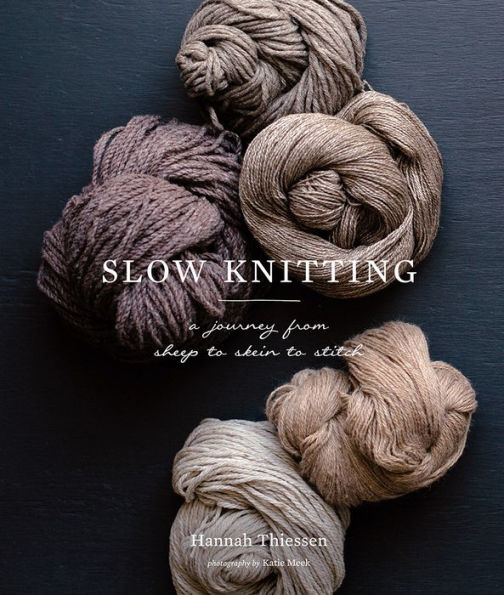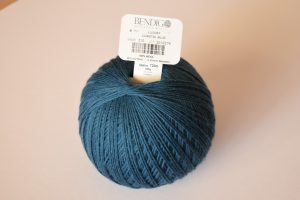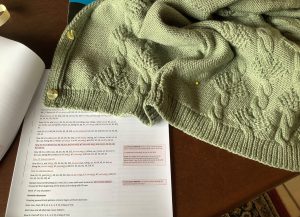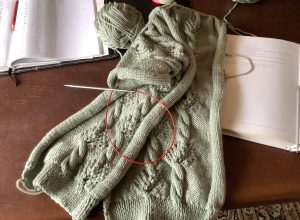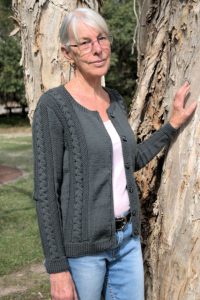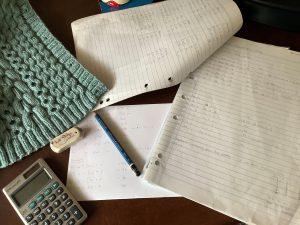In a post in 2018 I reviewed the book Slow Knitting by Hannah Thiessen. I recently returned to this book and it sparked new ways of thinking – about knitting and life in general.
I shared my thoughts in three posts in my Facebook group and thought I would share it with you.
Slow Knitting (part 1)
One of the great pleasures I get from living the life I lead is the time spent reading.
I have since childhood made reading an everyday priority. It is no wonder that I grew up to be a librarian, an owner of a specialised children’s bookshop, working many years working in publishing and as an editor.
When it comes to books, I love historical fiction, biography and non-fiction topics on social history especially anything to do with women’s lives throughout the ages.
When it comes to knitting books, I have a small, but growing collections covering topics like design and stitch dictionaries that I refer to all the time.
Yet, the books in my knitting collect that make me think and ponder are those like the one in the photo.
Why? Well, taking this one as an example, it makes me think about my craft and my life in a different light.
Slow knitting, the book, takes us through the journey of knitting from sheep or other fibre animals through to the finished product that we hold in our hands. It is about sourcing our yarn carefully, making our garments thoughtfully, thinking environmentally, experimenting fearlessly and exploring openly.
In the next few days, I want to share with you what all these mean for us as knitters and as women in the various stages of our lives.
I hope wherever you are, you are safe, happy and knitting.
Slow Knitting (part 2)
In her introduction to the book, Hannah Thiessen laments the constant movement of timelines, deadlines and other ‘blur of tasks fulfilled and checked off and crossed out ‘(p9) which make up most of our 21st century lives, and, sadly she writes our knitting lives are not exempt.
‘Long gone’ she writes, ‘are the days of early knitting discoveries; the once slow, halting gesture of making a knit stitch’ (p9). These are being replaced in part by the euphoria of finishing a project and racing on to begin another.
Enter the concept of slow knitting.
Slow knitting, like the slow food movement, is based on taking a step back from our busy lives. In terms of our knitting this means to re-evaluate how we source our yarn, the money we spend on projects and how we knit and share.
At its core is craftsmanship – that place where, ‘time spent making an object is just as important as the object itself’ (p10), This deliberate placing of craftsmanship at the helm ensures the five chapters of the book become, in so many ways, a precursor to new ways of thinking and being not only in our knitting but also in our lives generally.
Source carefully, the first chapter, expands on this idea of craftsmanship beginning with how we source the yarns we use and asking ourselves is this yarn the best yarn to use for the project in mind.
I would add that this is governed by the amount of money we wish to spend on a yarn. The price of a skein of yarn varies enormously and we choose according to our budget.
Nonetheless, yarn is the centre piece of our intended project and the question we need to ask is: will this yarn deliver the results required?
To answer this question is to swatch – to spend the time getting to know the yarn fabric and how your knitting influences it.
Taking the time to swatch also slows us down. Instead of rushing straight into casting on stitches and beginning the project, we take time instead to master the fabric of our choice – wool, acrylic, alpaca and much, much more.
We begin our journey into craftsmanship.
Slow Knitting (part 3)
In this, the third and final post about Slow knitting, I want to turn my attention to four things – making thoughtfully, thinking environmentally, experiment fearlessly and exploring openly, and what do they mean for us as knitters and as women.
Making thoughtfully returns us to the idea of craftsmanship and cherishing the time spent with the knitting project on hand. Thiessen, in the book, makes the connection between these two ideas as being one of setting no boundaries on time, it is the process and the journey that is the important.
Thinking environmentally is all about the process being part and parcel of the natural world – the life cycle of fibre from animal to skein.
Experimenting fearlessly is encouraging us to look and think about the stitches we use and using new techniques and materials.
Exploring openly is an important aspect to slow knitting in that it relates to community building. The rise in knitting groups both in person or online are a reflection of this and it is something us knitters like to do. We share our experiences.
As women, I think the concept of slow knitting has something to say in how we live our lives. It is about the journey, the joys, the highs and lows of our lives, it is about being present, being positive and willing to explore new directions.
It is about being the craftsman in our own lives.
Linda xx
